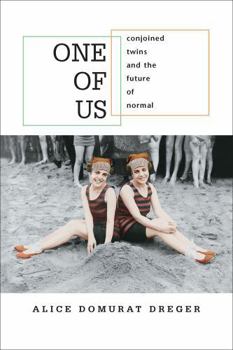One of Us: Conjoined Twins and the Future of Normal
Select Format
Select Condition 
Book Overview
Must children born with socially challenging anatomies have their bodies changed because others cannot be expected to change their minds? One of Us views conjoined twinning and other "abnormalities" from the point of view of people living with such anatomies, and considers these issues within the larger historical context of anatomical politics.
Format:Paperback
Language:English
ISBN:0674018257
ISBN13:9780674018259
Release Date:October 2005
Publisher:Harvard University Press
Length:208 Pages
Weight:0.50 lbs.
Dimensions:0.6" x 5.1" x 7.9"
Customer Reviews
4 ratings
Made me think about the way we perceive people that are born different
Published by Thriftbooks.com User , 16 years ago
This book was thought provoking. It made me think about what 'normal' is. From research that the author had done, it seems that a very high proportion of conjoined twins left conjoined are quite happy with their bodies. It seems that it is society that demands they are changed to a more normal appearance, despite horrible medical problems that will result from the operations. The book philophosises more about this than discusses actual cases. However there were some very interesting recent cases discussed, such as the sacrifice of one conjoined twin to save the other, and a case where the doctors took the parents of a pair of conjoined twins to court so the separation could go ahead.
Thought-provoking
Published by Thriftbooks.com User , 18 years ago
This book raises questions about peoples' reactions to conjoined twins that may have important implications for many other unusual traits. It eloquently questions common assumptions about the desire to seem normal. It has led me to wonder about the extent to which healthcare is used to make people more normal at the cost of making them less healthy. The book presents strong evidence that conjoined twins who remain conjoined are at least as well off as those who are separated, and some evidence that separations reduce the twins' life expectancy, possibly by a significant amount. Remarkably, of the twins who remained conjoined to adulthood, only one pair requested separation (they didn't survive it), and among those whose refused separation are a number whose twin had just died (which meant that separation appeared to offer the only chance for the remaining twin to survive). This doesn't mean conjoined twins are better off that way (those who have been separated seem equally satisfied with their status), but it strongly suggests that decisions to perform separations are motivated by something other than concern over the twins wellbeing. And it suggests that people who claim things like "The proposed operation would give these children's bodies the integrity that nature denied them" are imposing their values on others in ways which would be considered unacceptable if the victims had a little political power. The book reports a fair number of statements by doctors (and occasionally parents) which suggest they consider a normal appearance worth risking health to achieve. The book also theorizes that having a normal child is an important enough part of parents' identity to override their interest in their children's' wellbeing. The book also reports some indications that surgeons are biased toward surgery for unusual problems by the fame if can bring them. Unfortunately, there isn't as much evidence as there ought to be about the health effects of separations. The book claims (plausibly, but without supporting references), that "most medicine is not yet evidence-based", with most surgical decisions being based on storytelling rather than careful studies. The book raises some important questions about cases where doctors think the only way to save one twin is to kill the other. The author points out some strong similarities between the medical killing that is done in some of these cases and a hypothetical case where a heart is taken from a live singleton (i.e. not conjoined) donor to save another (which all would agree is wrong). One difference that she fails to consider is that if you consider the heart property, it looks like jointly owned property in one case and individually owned property in the other, and we should expect some differences to result from that (although doctors may still be more willing to kill one twin than that perspective would justify). One interesting example that the book provides of medicalizing a difference is the attempt to
An analysis of children born with anatomical abnormalities
Published by Thriftbooks.com User , 20 years ago
Conjoined twins, ambiguous genitalia, and birth defects are some of the issues considered in Alice Domurat Dreger's One Of Us: Conjoined Twins And The Future Of Normal, a hard-hitting analysis of children born with anatomical abnormalities, and the lives they lead. Unusual here is the viewpoint of those living with these anatomies, as well as the larger social and political perspective of what Dreger terms 'anatomical politics'. Chapters consider the results of separation on the hearts and minds of kids, and the elements which make for 'normalicy' in their lives in the intriguing study One Of Us, recommended especially for college-level collections strong in health and sociology.
From a Descendent of Conjoined Twins
Published by Thriftbooks.com User , 20 years ago
As a descendent of Eng Bunker (1/2 of the Original Siamese Twins), I was thrilled to read this well thought out and compassionate book. I would highly recommend this book to anyone striving to understand the issues that are faced with conjoinment and "singletons" need for privacy and individuality. An important book that helps "de-freak" the humans that are born with unique anatomy. Thank you!





